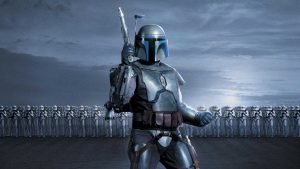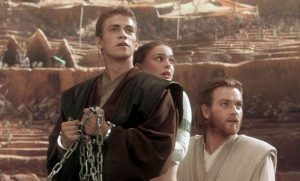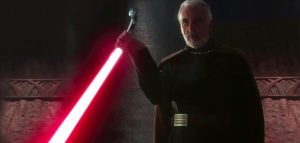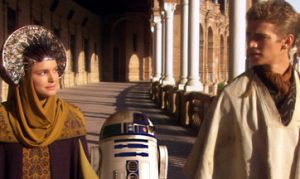SPOILERS FOR THE MANDALORIAN AHEAD!
Well, in case you were wondering, I don’t regret writing an entire, extensive, blog post detailing the geography, history, and ecosystem of the Jedi planet of Tython, because it was extremely fun to write. That this is the first episode of The Mandalorian that doesn’t really do a whole lot of worldbuilding is both surprising (considering the setting which, as you know from my post, is rich with Star Wars lore) and saddening (for the same reasons). There are fans who are currently annoyed because Tython is no longer in the Deep Core of the galaxy, and has instead been moved to the Outer Rim – contradicting even the new, official, canon – but I’m just disappointed that the set design was so small-scale this week. There’s one ring of standing stones, a measly excuse for a mountain (I mean, maybe it was just a very crumbled Tho Yor? It’s open for interpretation), and a severe lack of wild beasts. And don’t even get me started on how there were no Force-storms.

But hey, I begrudgingly respect Boba Fett (Temuera Morrison) again, so there’s that!
If you’ve been reading my blog for a while, you probably know that Boba Fett has never been one of my favorite Star Wars characters, and I didn’t squeal with excitement when he was teased in The Mandalorian‘s season two premiere because…I just didn’t find him all that interesting. He was the first Mandalorian introduced to the galaxy far, far away, so I suppose he deserves some kind of recognition for that – but he’s become outdated by other, far cooler Mandalorians, who have graced our screens since: even by his own father, Jango Fett, whom we saw in Attack Of The Clones. And no matter where Boba Fett showed up, whether it was in Return Of The Jedi or several excruciating episodes of Clone Wars, he always came off as stubborn and stuck-up to me. In fact, seeing his childhood in Clone Wars made it obvious that he had always been an arrogant, entitled, bully. He never changed or developed, and that made him boring.
So, unsurprisingly, the reason why he finally worked for me in this chapter of The Mandalorian is because Temuera Morrison (who previously played Jango Fett) brings a regal, commanding screen presence to this role that the character has never had before, as well as a maturity and sense of growth. Boba Fett was once little more than a banged-up suit of armor, but now he actually feels like a character: and an interesting one, too. He’s been humiliated countless times in the past – in fact, it’s become something of a running joke – but it feels like the writing has allowed him to learn from those mistakes at last, rather than simply erasing them from existence so he can be “cool”. It’s far cooler, in my opinion, for him to have undergone some serious character development during his time as a desert rogue.
But of course, that doesn’t mean the old banged-up suit of armor can’t still be important. In fact, it plays a major part in the awkward interactions between Din Djarin (our Mandalorian, voiced and sometimes played by Pedro Pascal) and Boba Fett, as it turns out Fett has been tracking the Razor Crest all the way from Tatooine (side-note: Temuera Morrison’s pronunciation of Tatooine as “TATween” is an extremely soothing vocal experience), hunting the armor that belongs to him…though why he didn’t take it from the far less experienced Cobb Vanth is a mystery to me. Tython was as good a place as any to finally corner Djarin, and better yet, this episode wasn’t already staked out for the live-action debut of a Clone Wars character, and/or a back-door pilot for an eventual spinoff (though Boba Fett is getting a spinoff, for which I am now a little bit more excited). Fett is initially disinterested in bargaining for the armor, and even threatens the Child as an intimidation tactic, telling Djarin that he has an accomplice with a sniper’s rifle trained on the baby.

It doesn’t take long for Djarin to figure out that accomplice’s name and identity: Fennec Shand (Ming-Na Wen), the same sniper he encountered on the sands of Tatooine back in season one. But she was far too awesome to bleed out at the hands of a wannabe gangster like Toro Calican, and it seems that Boba Fett patched her back up again with some new metallic upgrades. And while her debut episode in season one was so dark that you couldn’t see her amazing orange-and-black costume, this episode takes place in broad daylight and allows us a much better look at the character.
But anyway, back to the armor. Din Djarin is once again clueless, and completely makes a fool out of himself in front of one of the most revered Mandalorians in the galaxy, demanding evidence that Boba Fett is actually Mandalorian before he can give him the armor. And despite how awkward it all is, and how badly it reflects on Djarin, I kind of love that Djarin never shuts up about history and tradition, yet seems to know extremely little about his own culture’s history, and is constantly being called out on it. He’s definitely bold: I’ll give him that. Meanwhile, Boba Fett has an entire genealogy and Fett family history embedded in the chain code of his armor. Remember when I said after Chapter 11 that Din Djarin and his clan being revealed as the odd ones out in Mandalorian society made him a lot more interesting? This is the perfect payoff to that setup.
Just as the situation is cooling down and Din Djarin has finally struck a deal with Boba Fett to give him the armor in exchange for help protecting Grogu (who by this point has already reached the seeing stone and is seated there, encased in a protective Force bubble), Imperial stormtroopers arrive. Director Robert Rodriguez, whose previous credits include Alita: Battle Angel, delivers on brutal, fast-paced, action, and stunning visuals. He gives us the Din Djarin/Fennec Shand team-up I knew we needed the moment I first saw her character, though Shand gets plenty of solo moments to shine – and Ming-Na Wen, who played a Marvel superhero on seven seasons of Agents Of S.H.I.E.L.D., gets to show off her extensive fighting skills and agility. Rodriguez’ inventive use of Boba Fett’s legendary armor also deserves praise: especially since, last time we saw Fett using his jetpack, he was careening into a sarlacc pit (too soon?). Fett reclaims the old suit a bit prematurely, sneaking into the Razor Crest during the chaos and stealing it from among Djarin’s possessions – dangerous, but still easier than trying to educate Djarin about Mandalorian history. Like Djarin, his suit also comes equipped with a version of the “whistling birds”, and in his time on Tatooine he’s also picked up a Tusken Raider staff, which he uses viciously. There’s something so refreshing about watching Mandalorians smash large, heavy objects against stormtrooper armor.
Fett also owns a gunship, none other than the Slave One itself, and…well, I don’t know how he got his hands on it again, but I’m willing to go along with it because the Empire blows up the Razor Crest after the first wave of stormtroopers is unsuccessful, and Din Djarin is now in need of a ship. We all made fun of the Razor Crest, and how it needed to be repaired every ten minutes: but I do feel bad that it’s now just a heap of burning scrap metal, far beyond repair. The episode is aptly subtitled The Tragedy.
If that were the only tragedy, I’d probably manage. But it’s not. As many had guessed online given the short amount of episodes left in season two, Grogu is captured by dark troopers (the giant, hulking droid troopers teased at the end of Chapter 12), moments before Djarin and Shand reach the seeing stone to intercept them. As they fly back to the Imperial star-cruiser hovering in Tython’s atmosphere, we can just see the itty-bitty baby staring down at Din Djarin with wide eyes. This is the kind of tragedy that hurts. But of course, it gives us a clear direction for the remaining two episodes: and direction is something The Mandalorian has sorely lacked up until this point.

Collecting what little he can from the wreckage of his old ship, including the beskar steel spear given to him by Ahsoka Tano last week and the strangely significant metal ball that has been Grogu’s favorite toy for ages, Djarin determines to rescue the baby: and both Fett and Shand swear to help him since technically they never fulfilled their end of the deal, to protect the child. For some reason, they immediately pack up and head back to the planet Nevarro, where Djarin enlists the help of Cara Dune (Gina Carano, whose permanent smirk is growing extremely tiresome), now an official New Republic marshal, to locate a currently incarcerated individual whom Djarin hopes will be able to track down Gideon: Miggs Mayfield (Bill Burr), Imperial sharpshooter turned deadly mercenary. Djarin turned him in to the New Republic back in season one, and it appears Mayfield has been stuck doing heavy labor ever since, so I’m not sure what bond of friendship exists between the two that Djarin thinks he can exploit. Mayfield, you may recall, thought that Grogu was either Djarin’s pet or illegitimate child, so I don’t think the promise of being able to help the baby will be quite enough in this case.
And speaking of Grogu, he’s stuck in a holding cell on the Imperial starship; but his subplot is far from over. Moff Gideon (Giancarlo Esposito) arrives to interrogate the baby, only to find that Grogu is using his re-awakened Force powers to violently bash in the heads of his stormtrooper guards. Gideon is quickly able to subdue the exhausted infant, but doesn’t reveal any ulterior motive beyond what we already knew – he wants Dr. Pershing alerted immediately that the Empire has recovered its “donor”: for more on that, see my post regarding midi-chlorians. He does reveal the ancient Darksaber to Grogu, marking its first appearance since the season one finale. It takes this show a long time to pay off its various hints and teases.
The big question now is whether or not Grogu was able to contact anyone through the Force while seated on the seeing stone. Tython may have been a big disappointment, but if Grogu was able to summon a Jedi (or even better, a whole bunch of Jedi), the side-mission there might not have been in vain.
Episode Rating: 7.5/10




